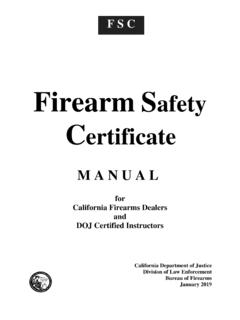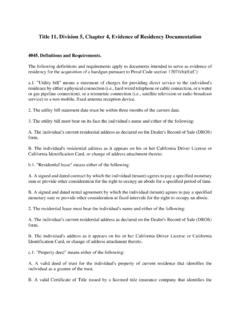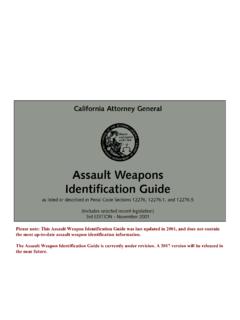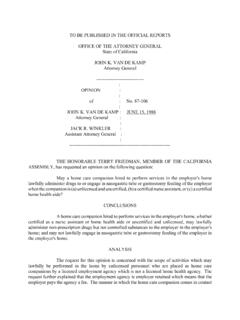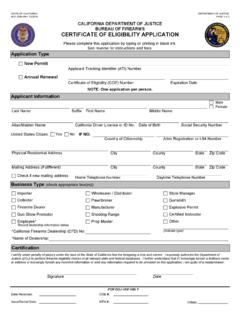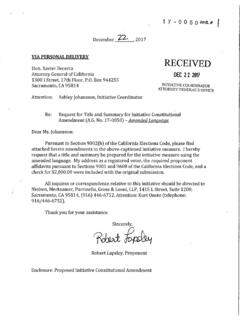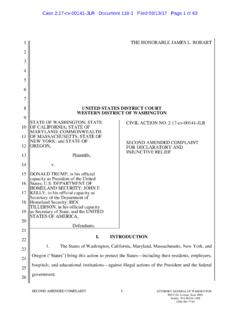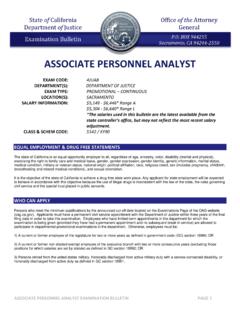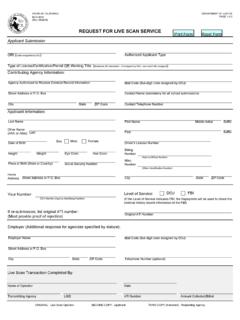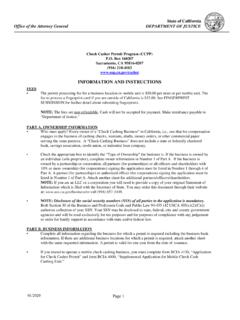Transcription of California Firearms Laws Summary - 2016
1 California Firearms Laws Summary 2016 California Department of Justice Kamala D. Harris Attorney General Table of Contents California Firearms Laws Summary 2016 Introduction .. 1 Persons Ineligible to Possess Firearms .. 1 Sales and Transfers of Firearms .. 3 Prohibited Firearms Transfers and Straw Purchases .. 5 Reporting Requirements for New California Residents .. 6 Shipment of Firearms .. 6 Carrying Firearms Aboard Common Carriers .. 7 Firearms in the Home, Business or at the Campsite .. 7 Transportation of Firearms .. 7 Use of Lethal Force in Self-Defense .. 8 Carrying a Concealed Weapon Without a License .. 10 Loaded Firearms in Public .. 10 Openly Carrying an Unloaded Handgun ..11 Punishment for Carrying Unregistered Handgun .. 11 Miscellaneous Prohibited Acts .. 12 New Firearms /Weapons Laws .. 14 California Firearms Laws Summary 2016 INTRODUCTION As the owner of a firearm, it is your responsibility to understand and comply with all federal, state and local laws regarding Firearms ownership.
2 Many of the laws described below pertain to the possession, use and storage of Firearms in the home and merit careful review . The California Firearms Laws Summary 2016 provides a general Summary of California laws that govern common possession and use of Firearms by persons other than law enforcement officers or members of the armed forces . It is not designed to provide individual guidance for specific situations, nor does it address federal or local laws . The legality of any specific act of possession or use will ultimately be determined by applicable federal and state statutory and case law . Persons having specific questions are encouraged to seek legal advice from an attorney, or consult their local law enforcement agency, local prosecutor or law library . The California Department of Justice (DOJ) and all other public entities are immune from any liability arising from the drafting, publication, dissemination, or reliance upon this information . PERSONS INELIGIBLE TO POSSESS Firearms The following persons are prohibited from possessing Firearms (Pen.)
3 Code, 29800-29825, 29900; Welf . & Inst . Code, 8100, 8103): Lifetime Prohibitions Any person convicted of any felony or any offense enumerated in Penal Code section 29905 . Any person convicted of an offense enumerated in Penal Code section 23515 . Any person with two or more convictions for violating Penal Code section 417, subdivision (a)(2) . Any person adjudicated to be a mentally disordered sex offender . (Welf . & Inst . Code, 8103, subd . (a)(1) .) Any person found by a court to be mentally incompetent to stand trial or not guilty by reason of insanity of any crime, unless the court has made a finding of restoration of competence or sanity . (Welf . & Inst . Code, 8103, subds . (b)(1), (c)(1), and (d)(1) .) 1 10-Year Prohibitions Any person convicted of a misdemeanor violation of the following: Penal Code sections 71, 76, 136 .5, 140, 148, subdivision (d), 171b, 171c, 171d, 186 .28, 240, 241, 242, 243, 244 .5, 245, 245.
4 5, 246, 246 .3, 247, 273 .5, 273 .6, 417, 417 .1, 417 .2, 417 .6, 422, 626 .9, 646 .9, 830 .95, subdivision (a), 17500, 17510, subdivision (a), 25300, 25800, 27510, 27590, subdivision (c), 30315, or 32625, and Welfare and Institutions Code sections 871 .5, 1001 .5, 8100, 8101, or 8103 . 5-Year Prohibitions Any person taken into custody as a danger to self or others, assessed, and admitted to a mental health facility under Welfare and Institutions Code sections 5150, 5151, 5152; or certified under Welfare and Institutions Code sections 5250, 5260, 5270 .15 . Persons certified under Welfare and Institutions Code sections 5250, 5260, or 5270 .15 may be subject to a lifetime prohibition pursuant to federal law . Juvenile Prohibitions Juveniles adjudged wards of the juvenile court are prohibited until they reach age 30 if they committed an offense listed in Welfare and Institutions Code section 707, subdivision (b) . (Pen . Code, 29820 .) Miscellaneous Prohibitions Any person denied firearm possession as a condition of probation pursuant to Penal Code section 29900, subdivision (c).
5 Any person charged with a felony offense, pending resolution of the matter . (18 U .S .C . 922(g) .) Any person while he or she is either a voluntary patient in a mental health facility or under a gravely disabled conservatorship (due to a mental disorder or impairment by chronic alcoholism) and if he or she is found to be a danger to self or others . (Welf . & Inst . Code, 8103, subd . (e) .) Any person addicted to the use of narcotics . (Pen . Code, 29800, subd . (a) .) Any person who communicates a threat (against any reasonably identifiable victim) to a licensed psychotherapist which is subsequently reported to law enforcement, is prohibited for six months . (Welf . & Inst . Code, 8100, subd . (b) .) Any person who is subject to a protective order as defined in Family Code section 6218 or Penal Code section 136 .2, or a temporary restraining order issued pursuant to Code of Civil Procedure sections 527 .6 or 527 .8 . Personal Firearms Eligibility Check Any person may obtain from the DOJ a determination as to whether he or she is eligible to possess Firearms (review of California records only).
6 The personal Firearms eligibility check application form and instructions are on the DOJ website at http://oag .ca .gov/ Firearms /forms . The cost for such an eligibility check is $20 . (Pen . Code, 30105 .) 2 SALES AND TRANSFERS OF Firearms In California , only licensed California Firearms dealers who possess a valid Certificate of Eligibility (COE) are authorized to engage in retail sales of Firearms . These retail sales require the purchaser to provide personal identifier information for the Dealer Record of Sale (DROS) document that the Firearms dealer must submit to the DOJ . There is a mandatory 10-day waiting period before the Firearms dealer can deliver the firearm to the purchaser . During this 10-day waiting period, the DOJ conducts a Firearms eligibility background check to ensure the purchaser is not prohibited from lawfully possessing Firearms . Although there are exceptions, generally all Firearms purchasers must be at least 18 years of age to purchase a long gun (rifle or shotgun) and 21 years of age to purchase a handgun (pistol or revolver).
7 Additionally, purchasers must be California residents with a valid driver s license or identification card issued by the California Department of Motor Vehicles . Generally, it is illegal for any person who is not a California licensed Firearms dealer (private party) to sell or transfer a firearm to another non-licensed person (private party) unless the sale or transfer is completed through a licensed California Firearms dealer . A Private Party Transfer (PPT) can be conducted at any licensed California Firearms dealership . The buyer and seller must complete the required DROS document in person at the licensed Firearms dealership and deliver the firearm to the dealer who will retain possession of the firearm during the mandatory 10-day waiting period . In addition to the applicable state fees, the Firearms dealer may charge a fee not to exceed $10 per firearm for conducting the PPT . The infrequent transfer of Firearms between immediate family members is exempt from the law requiring PPTs to be conducted through a licensed Firearms dealer.
8 For purposes of this exemption, immediate family member means parent and child, and grandparent and grandchild but does not include brothers or sisters . (Pen . Code, 16720 .) The transferee must also comply with the Firearm safety Certificate requirement described below, prior to taking possession of the firearm . Within 30 days of the transfer, the transferee must also submit a report of the transaction to the DOJ . Download the form (Report of Operation of Law or Intra-Familial Firearm Transaction BOF 4544A) from the DOJ website at http://oag .ca .gov/ Firearms /forms or complete and submit the form electronically via the internet at https://CFARS .doj .ca .gov . The reclaiming of a pawned firearm is subject to the DROS and 10-day waiting period requirements . Specific statutory requirements relating to sales and transfers of Firearms follow: Proof-of- residency Requirement To purchase a handgun in California , you must present documentation indicating that you are a California resident.
9 Acceptable documentation includes a utility bill from within the last three months, a residential lease, a property deed or military permanent duty station orders indicating assignment within California . 3 The address provided on the proof-of- residency document must match either the address on the DROS or the address on the purchaser s California driver's license or identification card . (Pen . Code, 26845 .) Firearm safety Certificate Requirement To purchase or acquire a firearm, you must have a valid Firearm safety Certificate (FSC) . To obtain an FSC, you must score at least 75% on an objective written test pertaining to Firearms laws and safety requirements . The test is administered by DOJ Certified Instructors, who are often located at Firearms dealerships . An FSC is valid for five years . You may be charged up to $25 for an FSC . Firearms being returned to their owners, such as pawn returns, are exempt from this requirement . In the event of a lost, stolen or destroyed FSC, the issuing DOJ Certified Instructor will issue a replacement FSC for a fee of $5.
10 You must present proof of identity to receive a replacement FSC . (Pen . Code, 31610-31670 .) Safe Handling Demonstration Requirement Prior to taking delivery of a firearm, you must successfully perform a safe handling demonstration with the firearm being purchased or acquired . Safe handling demonstrations must be performed in the presence of a DOJ Certified Instructor sometime between the date the DROS is submitted to the DOJ and the delivery of the firearm, and are generally performed at the Firearms dealership . The purchaser, Firearms dealer and DOJ Certified Instructor must sign an affidavit stating the safe handling demonstration was completed . The steps required to complete the safe handling demonstration are described in the Appendix . Pawn returns and intra-familial transfers are not subject to the safe handling demonstration requirement . (Pen . Code, 26850 .) Firearms safety Device Requirement All Firearms (long guns and handguns) purchased in California must be accompanied with a Firearms safety device (FSD) that has passed required safety and functionality tests and is listed on the DOJ s official roster of DOJ-approved firearm safety devices.
